Alejandra Piña rides sidesaddle, dressed in a traditional dress and a sombrero, at the Jacobson Building at the Iowa State Fairgrounds.
Writer: Brianne Sanchez
Photographer: Janae Gray
Equestrian teams parade into the arena sidesaddle, each rider gripping her horse’s reins in one hand while raising the other to the crowd. Wearing flouncing skirts, wide felt sombreros, bright lipstick and determined expressions, the young women personify the pageantry of their sport.
Known as charrería (cha-re-REE-a), the traditional rodeo and national sport of Mexico is a mix of art and athleticism, grace and grit. Its arrival in Iowa offers a cultural touchpoint for a multigenerational community that’s grown up on both sides of the border.
“I just love when people cheer because it feels like you’ve accomplished something big with your team,” said local rider Martina Jimenez, 19, who started riding 10 years ago. “It feels like a family when you’re in the group.”
Charrería is a demonstration of horsemanship and heritage. Within it, all-female escaramuza (eh-scara-MOOSA) teams inspired by female fighters of the Mexican Revolution compete in a series of synchronized riding demonstrations while wearing uniforms patterned after styles of the early 20th century. It’s such a spectacle that toddlers twirl and cross paths, preparing for the day that they take their place on a team. Little girls dress in elaborately ruffled gowns to practice routines on stick hobby horses. Here in Iowa, brave riders as young as 9 showcase their equestrian skills at full speed in demonstrations of daring that draw gasps and applause from spectators.
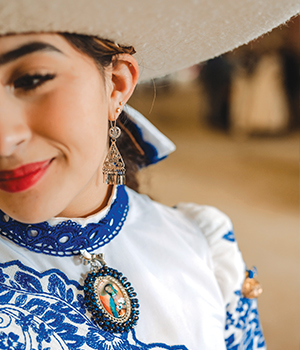
Dalia Gaytan and other charras wear images of the Blessed Virgin for good luck and protection.
Escaramuza Style
During the Iowa Horse Fair this spring at the Iowa State Fairgrounds, a brass band provided a jaunty soundtrack to the action in the arena. Male charros demonstrated their roping skills with neon-colored lassos that stood out against the sand, and dancing horses pranced in place along the perimeter.
Between events, the band kept playing outside the barn, where colorful banners fluttered between the stalls. Tubas, trumpets and drums delivered a romping rhythm that inspired an impromptu dance party, where two- and four-legged dancers showed off their fancy footwork. The whole delightful scene offered an up-close look at escaramuza style.
When Alejandra Piña and her teammates dress for a competition, they pay special attention to the details since teams are scored on costuming as part of the performance. After donning bloomers and petticoats and sashes and bows, they attach protective talismans to their beautifully embroidered dresses. Following tradition, the teams wear brooches, pins and tasseled charms depicting the Blessed Virgin to protect them in the arena.
“It’s kind of like a good luck charm to keep us safe on the horses,” said Piña, captain of Escaramuza Quetzalli, one of Iowa’s four escaramuza teams. “We’re riding a horse sidesaddle and it’s very dangerous. We’re not walking, we’re galloping.”
Watching the equestrian drill teams perform brings to mind the balance and poise of ballet, the precision of synchronized swimming and the stamina of horse racing. Teams of a dozen or more charge into the arena to perform choreographed maneuvers to music. They ride toward each other, pair off, fan out, cross paths and make tight turns in formation. The potential for collisions, or for a rider to slip from her saddle, is palpable.
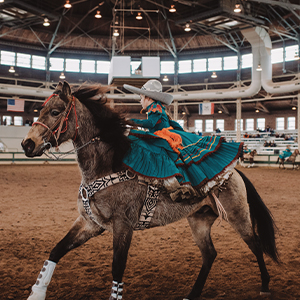
Hang on tight: Riders as young as 9 race around the arena with their older teammates.
Expanding Tradition
The Piña family helps coordinate charrerías and escaramuza competitions. Alejandra’s father, Juan Piña, is president of the Union of Associations of Charros of the State of Iowa and serves as master of ceremonies. He is a charismatic presence dressed in a handsome three-piece suit with an orange suede jacket fastened with silver clasps. He is definitely a showman, but his focus is on educating the audience about what to look for in each event and acknowledging the hard work each team puts into its performance.
“It is a great honor to exhibit this sport and to promote it,” Alejandra Piña said. Her team is looking forward to performing at more rodeos across the state and plans to travel as far as California and Mexico, where escaramuzas are especially popular. Here in Iowa, they adapt routines to the rules of their mostly Caucasian counterparts while staying true to their own style.
This spring at the State Fairgrounds, the four escaramuza teams competed against one another as well as American Western-style teams that often perform to country anthems, carry flags and spangle their horses’ hindquarters with glitter. Judges awarded points according to complex rules and a scoring system based on attire, timing and the execution of each exercise.
Piña, who works in the Iowa Attorney General’s Office when she is not riding, practices with her team every week. A coach in California advises the team on various aspects of the sport’s heritage while a local coach, Anna Garcia, handles the hands-on horsemanship skills.
At the Iowa Horse Fair, Piña’s Escaramuza Quetzalli team took first place. It was a victory for horses and humans alike.
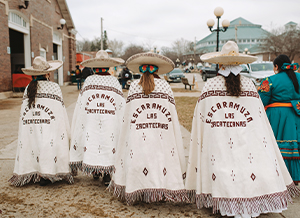
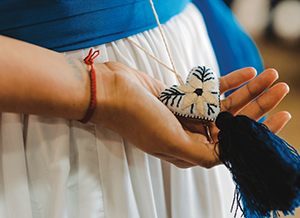
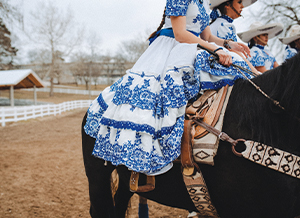
Escaramuza competitions can hinge on even the tiniest details stitched on a cape, an accessory or the hem of a dress.


Behind the scenes, teams adorn their horses’ stalls for good luck. Team captain Alejandra Piña takes a selfie with Martiza Jimenez and other teammates in their elaborate uniforms.
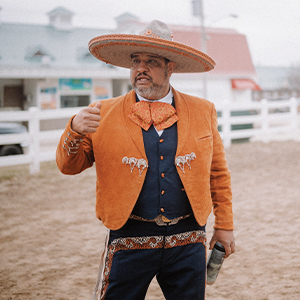
Juan Piña leads Iowa’s charro union and often serves as a ringmaster at events.








